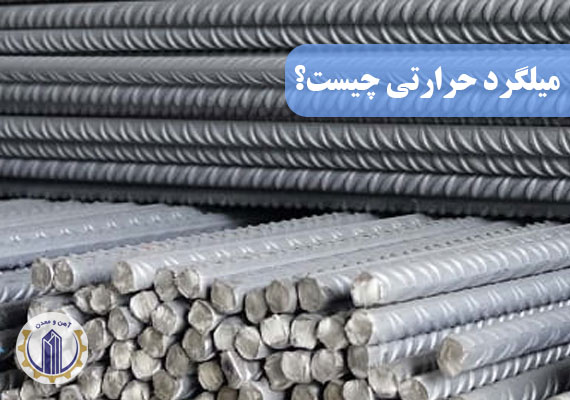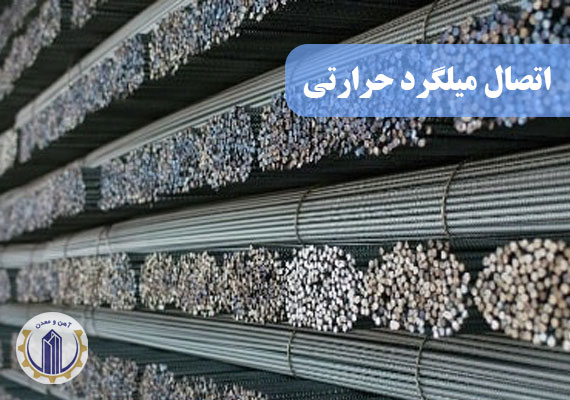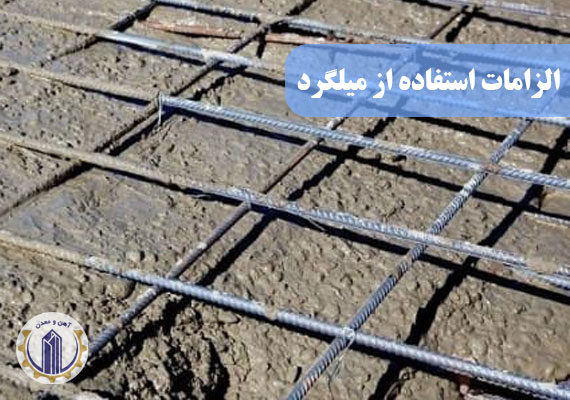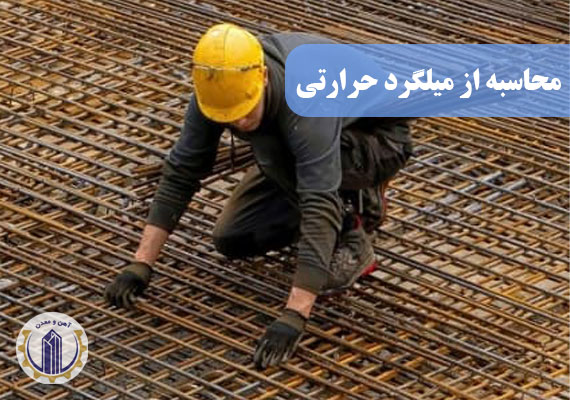?What is thermal rebar? What are its uses
Thermal rebar or thermal reinforcement is one of the components of the block joist roof. During the construction of small and large construction and development projects, many actual and potential factors have a negative impact on the construction process. For example, cracking of concrete immediately after drying or earthquakes that are likely to occur in the future. Also, changes in air temperature are among these problems. Structural engineers try to reduce or completely eliminate these problems with proven scientific solutions. For example, one of these cases is the use of rebar during the implementation of the block joist roof and concreting.
Concrete is considered one of the important materials in the construction industry. In addition to positive features such as high compressive strength, it also has disadvantages. One of the solutions that can significantly reduce the disadvantages of concrete is to use various types of rebar. One of the most important of them is called thermal rebar. The best profile production factories can produce the highest quality rebar.
Table of contents
Disadvantages of concrete, an introduction to the use of rebar
In buildings that use concrete and have concrete pouring stages, thermal rebar is used. You may be wondering, “Why is rebar used alongside concrete?” The answer to this question is related to the strength of concrete. In terms of compressive strength, concrete is one of the hardest building materials. That is, the ability of a structure to withstand the axial compressive loads it must withstand. The age of concrete and the percentage of compressive strength have an effect on the compressive strength test.
The tensile strength of concrete is very weak. This is where the role of rebar is defined alongside concrete. Tensile strength is the ability of concrete to withstand axial tensile loads. After drying, concrete will have a porous structure that causes tiny cracks in its structure. When a tensile load is applied to it, the cracks enlarge and the concrete eventually collapses.
Thermal rebar prevents all of the above. Increasing bending strength is another reason to use rebar. Flexural strength (modulus of rupture) is the ability to withstand lateral loads that come from both sides and are applied to a concrete structure in addition to compressive loads. When thermal reinforcement is used to increase tensile strength, the flexural strength of concrete also increases.

?What is thermal rebar
Now we want to get acquainted with thermal rebar. Rebar is a profile with a circular and solid cross-section that is produced in simple and ribbed forms (spindle rib, uniform rib and compound rib). Its raw materials are iron and steel. Iron, steel, ingot and cast iron are all obtained from iron ore. The first three options differ in the amount of carbon element. In contrast, cast iron is obtained by removing phosphorus and sulfur during iron smelting.
Usually, types of rebar are produced from steel. The higher the carbon element in the steel, the greater the strength of the final product (rebar, etc.). There are different types of rebar:
Epoxy
Galvanized
High-carbon
Steel (stainless)
Of course, according to Russian standards, rebar is divided into four categories: A1, A2, A3 and A4. The thickness of the rebar also varies from 4.5 to 32 mm. You may ask, “Why was the name of thermal rebar not mentioned among all the rebars?” The answer to the question is that thermal rebars are the same as ordinary rebars, but they are called thermal rebars because of their application and place of use. Of course, they are only used for block joist ceilings, because the surface will need to be concreted.
How to use and connect thermal rebar
Thermal rebar is used to build the roof, which is used in the upper third of the thickness of the concrete slab. They are placed on the left and right of the block beam roof. Their connection method is perpendicular to each other. The concrete slab is responsible for the vertical load. The rebars are connected to each other by cold welding, because hot welding reduces the thermal resistance of the rebar. There are two ways to connect thermal rebars to each other:
Due to the characteristics of each element in its pure form, about 90% of all types of metals are usually used as alloys. In the following, what is alloy sheet? We will introduce you to the types of steel alloy sheet and… Alloy sheet is marketed in two forms, sheet (cut sheets) and coil.
Cross-connection: After placing two rebars on top of each other perpendicularly, the wire is tied crosswise from top to bottom
Side connection (tie): After the rebars are placed on top of each other, a wire is passed under the lower rebar and past the upper rebar and twisted. During connection and installation, care must be taken not to bend the thermal rebar, because the bending resistance of the rebar is very low due to its thin thickness

Applications of thermal rebar
An important issue regarding thermal rebar is why it is used in construction? The use of rebar is related to two important parts:
The first point is that its use increases the strength of the roof, because it bears a large amount of the building’s load. The horizontality of the roof increases the level of vulnerability. So thermal rebar prevents damage from earthquakes and fires. It will also bear the additional load.
The second point, which is more important, is increasing the tensile and bending strength of concrete. Several factors cause damage and cracking of concrete. One of them occurs immediately after the concrete dries. When the moisture dries from the concrete texture, it is left empty and cracks form. So-called concrete shrinks (tensile stresses). It goes without saying that the formation of small and superficial cracks is completely natural. Using thermal rebar and creating a bond between the concrete and the rebar prevents shrinkage and the transformation of small cracks into large cracks and fractures.
Even when moisture and acidic substances enter these cracks, it will prevent the formation of large cracks. Pressure, high load, as well as temperature fluctuations (high cold and heat) also cause concrete to crack. Thermal rebar will prevent the effects of these factors on concrete. This is because rebar has a more flexible texture than concrete and reacts faster to temperature fluctuations. Another function is to integrate the force from the additional load that is applied to the roof. Concrete that is strengthened with thermal reinforcement is called reinforced concrete.

Requirements for the use of rebar
In the National Building Code, the use of thermal rebar is not mandatory, but rather recommended. Many engineers have a positive opinion about the use of rebars. In other words, positive opinions outweigh negative opinions. Thermal rebars should be connected in the upper third of the thickness of the concrete slab and their connection is also of the cold type. This type of rebar should be ribbed, because the connection and grip between the concrete and the rebar reaches the maximum possible level.
The minimum thickness for thermal rebar is 6 to 8 mm. If used, it is better to choose a size of 8 mm, because less than that will reduce the bending strength.
The way the rebars are connected is such that a checkerboard grid will be created. The rows of rebars are perpendicular to each other and completely parallel. The distance between the rebars is directly related to the thickness of the roof. That is, the distance between the rebars should be 5 times the thickness of the roof. Their distance is standardly between 25 and 35 centimeters. The last point is that their distance should not exceed 50 centimeters.

Calculating the amount of thermal rebar used in the ceiling
For the use of thermal rebar, the opinion of two authorities is important. First, attention to the national building regulations and second, the opinion of structural engineering should be considered. The calculations that have been obtained for the amount and method of using rebar should be considered. The type of rebar, the size of the rebar, the amount of rebar required and the method of calculating the maximum allowable weight for the use of thermal rebar should be determined by the structural engineer. The important point is that the total weight of the rebars should not impose additional weight on the structure and building.

Advantages of using rebar in concrete
The use of thermal rebar and rebar in general in concrete constructions brings important advantages. The first and most important advantage is that it will increase the strength of concrete several times. This strength is manifested against pressure, impact and vibrations. Of course, the type of rebar, its resistance and thickness play a decisive role.
If rebar is used in concrete, the thickness of the concrete will certainly be reduced, because if concrete is used alone, it must be thicker (more expensive). Another advantage is the increase in the useful life of the structure or building. The method of using and installing rebar is also very easy. Of course, you should seek help from people who have the necessary expertise and experience or work under the supervision of a structural engineer. It saves costs (in the future). It also protects the structure from fire and the possibility of building collapse.
Communication bridges
Time table
Providing an official invoice
Shipping to all locations
Best price guarantee
Check sale
Taban Asia Steel Company, under the brand name of Ahan Madan, is a consortium of long-standing players in the steel industry, which, relying on the technical and specialized power and years of experience of the steel veterans working in these companies, works in the direction of meeting the needs of customers and their conscious purchase from the Iranian steel market. does Relying on our hardware support, such as a warehouse with an area of ten thousand square meters with a covered hall, supplying and trading all steel sections, providing valid certificates to guarantee the quality of products, support services until the moment of delivery, and also providing special services for the country’s manufacturing industries on an exclusive basis. , is trying to create a safe environment for consumers.
- All material and intellectual rights are reserved for this site
- Design and SEO of Taban Asia Steel Company




